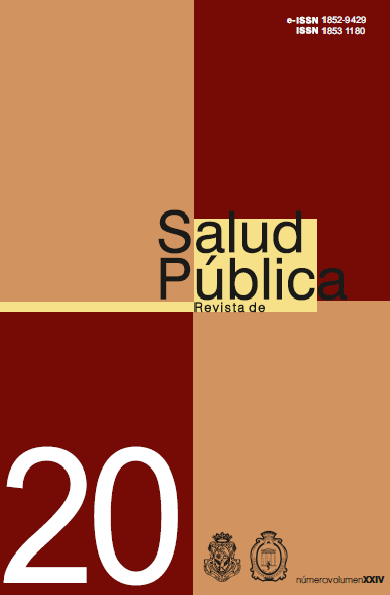FACTORS ASSOCIATED WITH DENTAL FEAR AND ANXIETY IN PARENT-CHILD DYAD
Comunicación Breve
DOI:
https://doi.org/10.31052/1853.1180.v24.n1.24654Keywords:
Dentistry, Fear, Anxiety, Public HealthAbstract
Introduction: Oral diseases are a problem in public health at individual and community levels, related to life quality of individuals and defined as a perception of functional, psychological and social aspects together with pain and comfort. Material and Methods: Cross sectional, analytical, quantitative, observational study. It was made up of 398 children (convenience sampling) aged between 5 and 12, both sexes, all patients from the Department of Pediatrics, School of Stomatology, Universidad Autónoma de San Luis de Potosí, México, treated from December 2015 to November 2016. Surveyed parents (n=398) aged between 18 and 60, both sexes, taking the children treated at the clinic. Results: A significant positive correlation was found. oefficient = 0.336 and p<0.001; with this it is demonstrated that perception of pain intensity was the same. Results of
McNemar test showed p=1.00, that means that opinion about the pain scale before was the same after treatment. Conclusion: There is a relationship between dental anxiety and fear with factors such as socioeconomic level but more research on the topic is necessary and extend sample size.
Downloads
References
Inglehart, MR, Bagramian RA. Oral health related quality of life. Chicago, IL: Quintessence Books 2002.
Hakeberg M, Berggren U, Carlsson SG. Prevalence of dental anxiety in an adult population in a major urban area in Sweden. Community Dent Oral Epidemiol. 1992; 20: 97–101.
Glendor, U. Aetiology and risk factors related to traumatic dental injuries: A review. Dental Traumatology 2009; 25: 19-31.
Klaassen MA, Veerkamp JS, Hoogstraten J. Dental fear, communication, and behavioural management problems in children referred for dental problems. Int J Paediatr Dent 2007; 17(6): 469-477
Celeste RK, Nadanovsky P, Fritzell J. Trends in socioeconomic disparities in the utilization of dental care in Brazil and Sweden. Scand J Public Health 2011; 39(6): 640–648.
Donaldson AN, Everitt B, Newton T, Steele J, Sherriff M, Bower E. The effects of social class and dental attendance on oral health. J Dent Res 2008; 87(1): 60–64.
Johansson G, Ostberg AL. Oral health-related quality of life in Swedish young adults. Int J Qualitative Stud Health Well-being 2015; 10: 27125
Wide B, et al. Oral health-related quality of life, sense of coherence and dental anxiety: An epidemiological crosssectional study of middle-aged women. BMC Oral Health 2012; 12: 14.
Llompart G, Marin GH, Silberman M, Merlo I, Zurriaga O. Oral health in 6-year-old schoolchildren from Berisso, Argentina: Falling far short of WHO goals. Med Oral Patol Oral Cir Bucal. 2010; 15 (1): 101-5.
Venham L, Bengston D, Cipes M. Children's response to sequential dental visits. J Dent Res 1977; 56(5): 454-459.
Wennström et al. Trends in tooth loss in relation to socio-economic status among Swedish women, aged 38 and 50 years: repeated cross-sectional surveys 1968-2004. BMC Oral Health 2013; 13: 63
Downloads
Published
Issue
Section
License
Copyright (c) 2020 Escuela de Salud Pública y Ambiente. Facultad de Ciencias Médicas. Universidad Nacional de Córdoba

This work is licensed under a Creative Commons Attribution-NonCommercial 4.0 International License.
Authors who have publications with this journal agree to the following terms:
The generation of derivative works is permitted as long as it is not done for commercial purposes.
The original work may not be used for commercial purposes.
Authors are allowed and encouraged to disseminate their work through professional social networks or on their website, after the publication process, in order to increase the visibility of their research.







